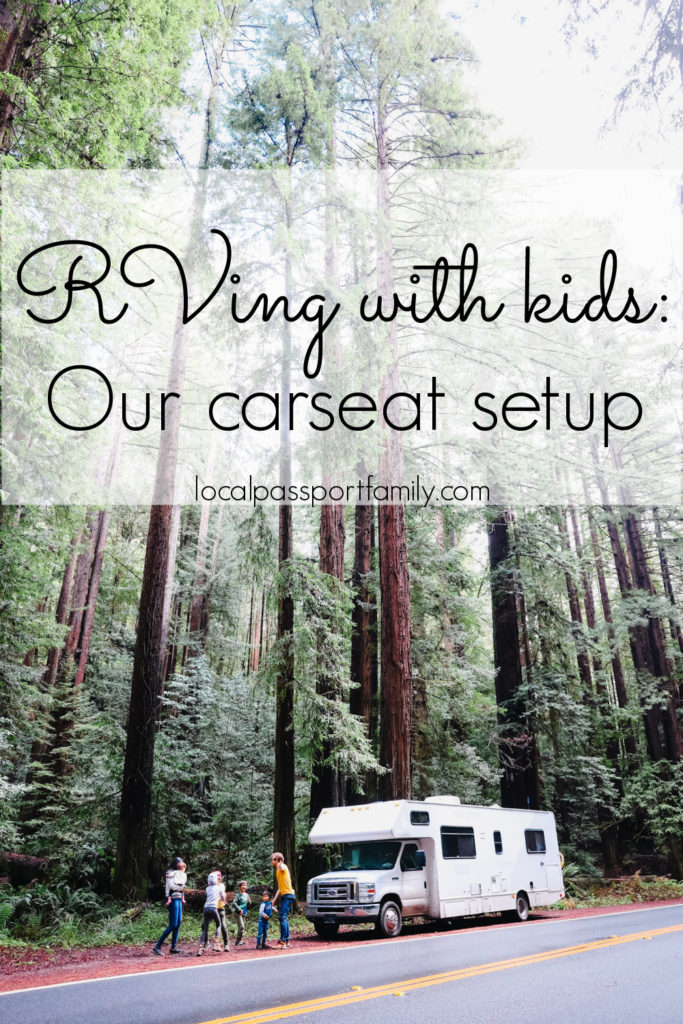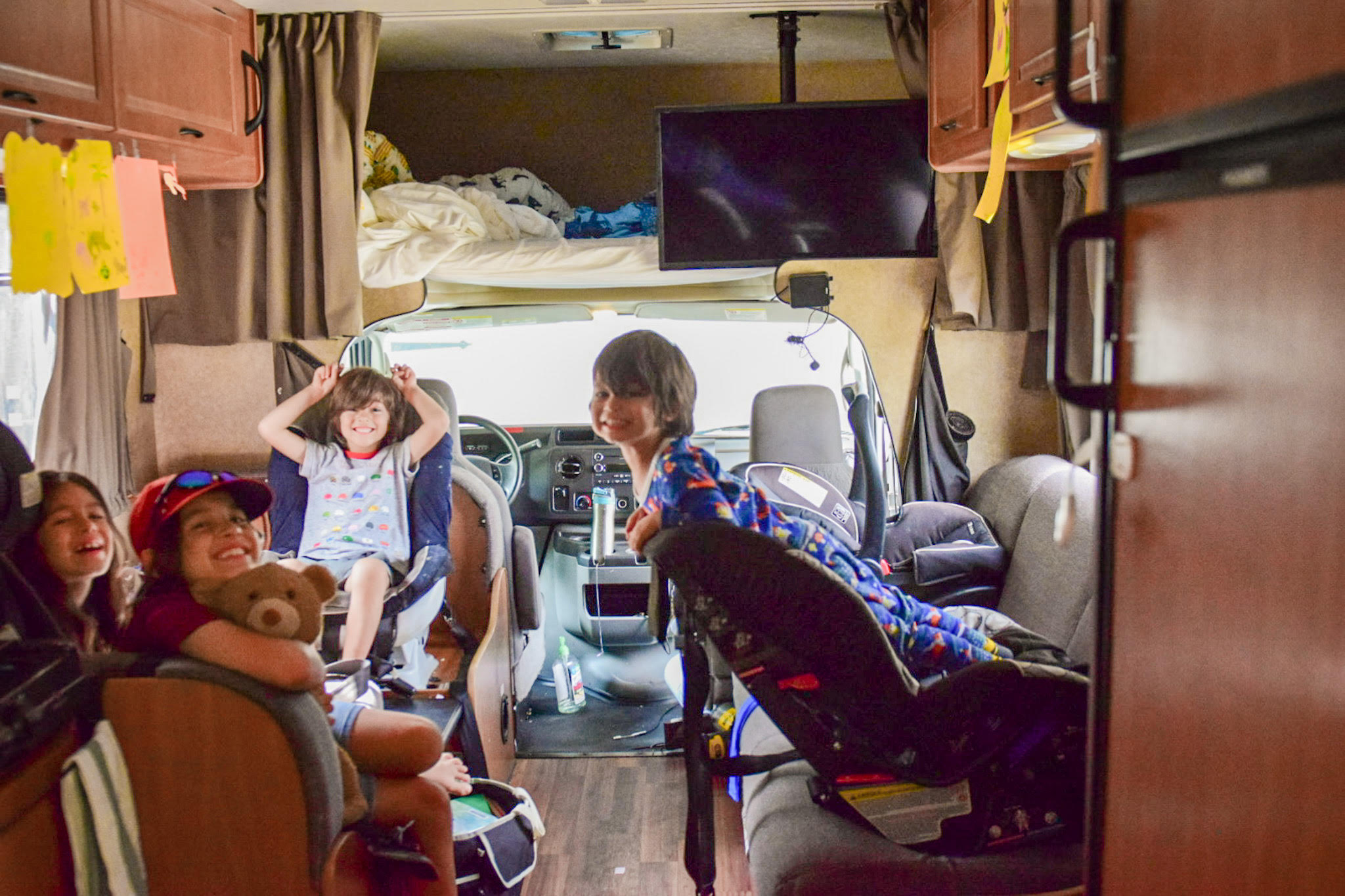I wrote previously about why we started RVing with kids, and also the safety considerations when putting car seats in RVs. Our research made us feel comfortable that if we could meet those safety requirements and follow all of our additional precautions, that we could install carseats in a RV to travel safely with kids.
In this post, I’ll discuss:
- our family’s everyday car seats,
- which car seats the Child Passenger Safety Technicians (CPSTs) recommended we use in the RV with kids,
- and how we installed our car seats in our RV and safety protocols the CPSTs recommended.
Start by reading my Car Seats in RVs: Safety Considerations post!
As I’ve stated previously, I am NOT a Child Passenger Safety Technician, so I relied on multiple other CPS Techs to glean information and expertise. I am also NOT advocating for anyone else to choose our same path; the question of can you put car seats in an RV is and must be your own.
However, I often find it helpful to see how others have balanced safety considerations to make reasonable and practical decisions for their families, including with a motorhome child car seat. This is also true when in an RV with kids. I hope that sharing our research and experience helps those of you considering RVing with kids, too.
Table of Contents
Best Everyday Car Seats for Our Family
At home, we drive a minivan (which almost feels like a necessity with 5 small children – sliding doors forever!!). Here are the child restraints we use on an everyday basis:
9 Year Old Car Seat
- Weight: 70 lbs
- Restraint: Low-back booster seat
- Minivan position: Back row, middle
- Why we chose it: We switched to a booster just after he turned 9, when he was approaching the weight limit on his 5-point harness. We chose a low-back instead of a high-back due to space constraints in the back row.
7 Year Old Car Seat
- Weight: 53 lbs
- Restraint: Forward-facing 5-point harness
- Minivan position: Back row, left side
- Why we chose it: Our kids have generally been on the smaller end of the weight spectrum, especially in the earlier years, so we tend to keep them restrained longer than others might. Our daughter is still well within the forward facing car seat weight limit. And while she is tall, she has a shorter torso, so still fits in it fine height-wise.
- Though it converts to a booster (and feels like one), we haven’t switched to the booster setting yet (and she’s not bothered by the 5-point harness). Also, since our daughter is tall for her age, we like that this car seat has a relatively heigh height limit for the 5-point harness setting.
5 Year Old Car Seat
- Weight: 35 lbs
- Restraint: Convertible 5-point harness, installed forward-facing
- Minivan position: Back row, right side
- Why we chose it: This is our favorite convertible car seat, and our son is still well within the limits.
2 Year Old Car Seat
- Weight: 24 lbs
- Restraint: Convertible 5-point harness, installed rear-facing
- Minivan position: Captain’s chair (middle row, left side)
- Why we chose it: Told ya we love this seat! Our son is still well within the rear-facing height and weight limits. We extended rear face our children, and typically turn them between 3.5-4 years of age.
5 Month Old Car Seat
- Weight: 11.5 lbs
- Restraint: Rear-facing infant bucket car seat
- Minivan position: Captain’s chair (middle row, middle position)
- Why we chose it: It’s a great and simple infant seat.
Which RV Car Seats: Car Seat in Motorhome
Most of our kids were able to use their everyday car seats while traveling in the RV. I’ll explain more about the configurations and how we installed the car seats in the RV below. Our 7 and 5 year olds remained in their forward-facing car seats, while the toddler and infant were able to stay rear-facing. That all seemed fairly straightforward when figuring out how to RV with car seats.
The trickiest child restraint was for our 9 year old, who is typically in a low-back booster seat. Every child (and every person in the vehicle!) needed to have some sort of upper body restraint, and since the back only had lap belts, we knew we couldn’t use a booster. There were a few RV seats we considered, including having him sit in the front seat with a booster and lap-and-shoulder belt. However, we didn’t feel great about putting him in the front seat. Additionally, that would have meant that one adult was sitting in the back with only a lap belt – also not ideal.
So we started looking into a couple options to properly restrain him. I originally really wanted him to be in a 5-point harness like the other kids. Almost all 5-point harnesses, however, max out at a 65 lb weight limit, and he is just over that (70 lbs). I did find this car seat that technically has an 85 lb weight limit. However, I talked to a couple of car seat experts, who were VERY skeptical it would actually perform up to that weight. Additionally, it has a 52″ height limit, which our child had definitely passed. So that wasn’t a great option.
Which Child Restraint for an Older Child: Car Seat Vest
Since a 5-point harness wasn’t an option, I started looking into the Ride Safer Travel Vest. We’ve owned the small size vest for 6 years, and have taken it on many domestic and international trips. So we started looking into the large size vest for our 9 year old.
The Ride Safer vest is completely safety tested and provides terrific protection. And unlike traditional boosters, this car seat vest comes with an optional tether anchor when a shoulder belt is unavailable. This means it’s perfect when there is only a lap belt option, assuming there is a tether point available.
Since I originally thought a 5-point harness would be safest, I did ask the CPST if he would recommend using the 65 lb weight limit 5-point harness (even though our child was a few pounds over the limit) instead of the travel vest car seat. (This was before I realized our child also exceeded the height limit on the 5-point harness.)
The CPST pointed out that the vest may actually be even safer than the 5-point harness car seat in this case. This is because with the 5-point harness, the seat/belt are then bearing the load of not only the child (who was just over the weight limit), but also the heavy car seat. With the vest, there was a much lower weight load since the vest itself weighs almost nothing.
Installing Forward Facing Car Seats in An RV with Kids
Anchoring Forward Facing Child Restraints in an RV
Any RV forward facing car seats needs to use a top tether to anchor the top of the seat so it doesn’t fly forward. This gets tricky with lap-only belts, as there are no carseat RV anchors.
Our particular RV had two anchor points built into the two forward-facing dinette seats in the back. These are the seats that were pull tested. Based on our conversations with the vehicle manufacturer and the CPSTs, we were confident in these built-in anchor points carrying the load of a tethered car seat. All of the CPSTs suggested we put our heaviest two forward-facing children in those seats: the 7 and 9 year old.
Anchoring A Forward Facing Child Restraint Without an Anchor Point
That left us with one more forward-facing car seat without an anchor point (the one for our 5 year old). Fortunately, The Ride Safer folks also make something called an Energy Absorbing Tether Anchor Loop (EATAL). Basically, it’s a loop with a metal anchor attachment on one end that you can use to create an anchor point in a vehicle when there isn’t one available.
This way, you can tether the top of a forward-facing car seat even without a built-in anchor point, so long as there is a secure place to anchor the EATAL. In other words, if tyou can loop the EATAL around a sturdy place (e.g., a metal bar that’s also bolted to metal so it is structurally sound, perhaps on the bottom of the front captain’s chair), then you can create your own anchor point.
The EATAL allowed us to then tether our third forward-facing car seat, since we do have a structurally sound metal bar available to tether it. We were able to place this child/seat in a rear facing motorhome dinette seat, but buckled in a forward facing position – essentially using it as a forward facing seat but facing the rear of the RV. Then we tethered the top of it to a metal bar under the RV driver seat, the back of which faces the back of this child seat.
Forward Facing Carseat 5-Point Harness or Ride Safer Vest for 5 Year Old?
I did debate using the small size Ride Safer vest with our 5-year old instead of a 5-point harness. After all, Ride Safer guarantees testing the EATAL with the vest. Plus, our child has worn it before. However, our 5-year old is small enough and does occasionally fall asleep in the car, so I felt more comfortable with him in a 5-point harness.
Because he is still well under the weight limit of both his car seat and also the EATAL, I felt better about using the car seat + EATAL option than the the travel vest + EATAL option. The CPSTs also recommended this to me.
To be clear, the EATAL is ONLY safety tested with the Ride Safer vest. Since our 3rd kiddo is still well under the weight limit of the large vest (which the EATAL is tested with), and is also well under the weight limit of the car seat itself, we felt okay about anchoring with the EATAL. At the very least, even if it ever failed in a crash, it would at least absorb much of the impact prior to failing. That’s definitely better than nothing. Still, know that this is not something that has been specifically crash tested.
Installing Rear Facing Car Seat in RV with Kids
RVing With A Baby: Infant Car Seat in RV
Once we were clear on how to tether all the forward facing car seats, it was much easier to figure out the rear-facing toddler and infant car seats in an RV. Since rear-facing car seats can be installed with a lap-only belt, that gave us more flexibility with where to place them. Putting the rear-facing convertible car seat and the infant car seat in an RV was pretty straightforward. RVing with a baby already felt new and uncharted, but this part was consistent amongst the CPSTs.
While I didn’t love having the two youngest children on a side-facing RV bench, the CPSTs pointed out that the 5-point harness seats, especially the infant bucket seat, are side impact tested. I definitely didn’t want them on the rear facing RV bench seat in a rear facing car seat (because that would essentially put them in a forward-facing position toward the front of the vehicle). So that left the side-facing option. While it isn’t the closest to the middle of the vehicle, they are still centered front to back, providing protection to these car seats in motorhomes.
Car Seat in RV with Kids: How to install car seat in motorhome
The final piece was nailing down the official configuration. We had a pretty good idea at this point, and settled on the following:
9 Year Old RV Car Seat
- Restraint: Ride Safer travel vest
- RV Position: forward-facing dinette seat with built-in anchor point
- Notes and considerations: We knew we needed to put our oldest child in one of the two forward-facing seats with the anchor points, as our two heaviest children needed to go there. The cushion was preventing a totally tight tether, however. So we removed the cushions from behind and underneath, and just had our son sit on a thinner cushion. That way, we were able to get the vest plenty secure.
7 Year Old RV Car Seat
- Restraint: Forward-facing 5-point harness
- RV Position: forward-facing dinette seat with built-in anchor point
- Notes and considerations: Like with our oldest, to get a tight enough tether, we removed the cushions from underneath and behind the seat.
5 Year Old Car Seat in RV
- Restraint: Convertible 5-point harness, installed in forward facing position but facing the rear of the vehicle
- RV Position: backward-facing dinette seat, creating a top tether point using the EATAL and anchoring to a metal bar under the driver’s seat
- Notes and considerations: Since he was in a forward-facing car seat installed on a backwards-facing bench, he was essentially in a rear-facing position in the vehicle (facing toward the back). Since he’s still under the maximum rear-facing weight for his car seat, we could also theoretically install the seat in a rear-facing position on the rear-facing seat, which would put him facing the front of the vehicle. Doing so would eliminate the need for the EATAL, since installing in a rear-facing position can be done with only a lap belt.
- The biggest reason we didn’t do this is that he has pretty long legs and would’ve been fairly uncomfortable with them bent against the seat back. It also meant that he wouldn’t be facing his two forward-facing siblings. We found a tether point for the EATAL under the driver’s captain’s chair, which was bolted to metal. We also removed the seat cushion from under and behind his seat to get a tight tether.
2 Year Old Carseat in RV
- Restraint: Convertible 5-point harness, installed rear-facing position
- RV position: Side-facing bench
- Notes and considerations: This was an easy one to install rear-facing with the lap belt.
5 Month Old Car Seat in RV
- Restraint: Rear-facing infant bucket car seat
- RV position: Side-facing bench
- Notes and considerations: This baby seat in RV was another easy one to install rear-facing with the lap belt.
While our seats and configurations definitely err on the conservative side for restraining our children to the highest possible level, it’s always wise to check seat belt and RV car seat laws in your state. RV car seat laws and RV seat belt laws vary drastically so be sure to read carefully and follow all local rules.
Whew! Did you make it to the end? I hope sharing our experience, tips, and tricks for which car seats and the configuration we used in our RV with kids was helpful to you. What questions do you have on how to install car seats in a RV? Please drop them in the comments below!
IF YOU LIKED THIS POST ABOUT PUTTING CAR SEATS IN RV WITH KIDS, YOU MIGHT LIKE THESE POSTS TOO:
- 4 Kids, 43 Countries, 20 Must Have Travel Essentials
- 10 Tips for Getting Over Jet Lag with Kids
- Traveling with a Car Seat: Tips and Tricks
NOT PLANNING TO PUT CAR SEATS IN RVS QUITE YET? PIN THIS POST FOR LATER!













[…] not using the other twin pullout bed (where the dining table would be) and instead store the extra car seats […]
[…] reading here to see which child restraints and seat configuration we normally use in our family vehicle, as well […]
[…] advantage is that you have all your same child safety seats in your RV with kids. So you know you can install all your safety seats properly, and you don’t have to install […]
We just picked up our new class C and I’ve been making myself a little crazy trying to figure out the car seat situation! Thank you for writing this! We have two children so we can use the two anchored lap belts on the forward facing dinette seat. My son is 5 so a forward facing 5 point harness seems pretty straightforward for him. But my daughter turns two in 2 weeks, and her seat can’t fit rear facing in that bench because of the recline angle. I can’t figure out if it’s better to have her forward face in the dinette next to her brother? Or install her forward facing in the rear facing dinette seat which ultimately puts her in a rear facing position? I wondered if any of your conversations with the CPSTs gave you insight into that!
I’m so glad it was helpful! I made myself crazy researching, too, so I’m glad someone else can benefit. 😉
Can you install the toddler’s seat rear facing at the tether point if you remove the dinette table? If so, that’s what I would do. I suspect you’ll need to remove the table for legs to fit with the forward facing seat, anyway. And though you won’t need the tether point for the car seat in a rear facing position, the two forward-facing spots are the safest as they have been pull tested (at least they were in our RV).
If that doesn’t work, I would probably put her forward facing in the seat next to her brother (Though I’m obviously not a CPST, so please do double check with one). Since there’s a built in tether point there and that spot has been pull tested, it’s going to be more secure than the rear-facing bench. And since she’s close to 2, I would personally take the benefit of that over the benefit of extended rear facing (since then you’d need to create a tether point for the car seat on the rear facing bench – it’s obviously doable and we did it, but only because we had 3+ kids. The two FF dinette positions are the first two spots I’d use, though).
Whew! Hope that helps and feel free to email me with more questions!
I so appreciate your thorough car seat explanation! We just got our first campervan and I’ve had just so much stress figuring this out! It’s so helpful to see how another family has managed this very tricky issue.
I’m so happy to hear it was helpful! You’re so right that it gets very complicated. Feel free to reach out with any other questions!
[…] support for younger children, or can be tethered for older kids if needed. It was perfect for us in the RV since we couldn’t use a traditional booster since there wasn’t a shoulder belt, but […]
Thank you so much for this post and the details you provided! We just bought a 22′ Class A from 86′ so the only option for belts is the driver and passenger seats, and the lap belts on the side facing couch (for an almost 5 and 7 year old). I was also going a bit crazy trying to figure out how to make this as safe as possible, and reading your solutions has helped quite a bit. It sounds like the critical pieces are ensuring the lap belts and tether belts are sufficiently secured to the frame/ metal, and that the vest is a good alternative to a child who is too big for the 5 point car seat. So glad I found your blog, and love your content!
Congratulations on your RV purchase! I’m so happy this was helpful to you. I felt the same – researching so much to try to figure out the safest option. Feel free to reach out with any questions!
[…] also use the large size vest for our child who has outgrown a 5-point harness while in our RV since a traditional booster isn’t safe in there since there are only lap belts. It works […]
Thank you so much for posting this! We recently bought an 87 class A motor home and I have been going crazy because we only have the side facing bench as an option to put our 1 year olds car seat. the dinette doesn’t have belts and wasn’t so comfortable putting him in the front passenger seat. We are about to move cross country so I’m nervous but I can’t live in fear! Your post helped 🙂
I’m so happy to hear it was helpful!! Please feel free to reach out with any questions!
Thank you for sharing! We are wanting to rent a Class C RV but need to figure out if we can fit our 5 kids in it safely. Do you have any tips about how to tell if the seat you are strapping the car seat to is structurally sound (bolted to the metal frame) or not? I imagine some are easy to see, but that it might be hard to tell sometimes (like with dinette seats, etc.) … thank you so much!!
Hello! Thank you so much for posting all of this info!!
I was wondering if you considered rear facing your youngest in the front passenger seat if the air bag could be turned off? I had read in another article that that may be the safest spot for an infant but then like you said an adult then gets only a lap belt in the back. Ugh so tough figuring this all out.
Another question, how did you choose your 5 point harness car seat? Was the particular one you had a better fit in an RV? Or did you just use what you had?
Same question for the convertible car seat.
Thank you so much for your time! 🙂
Thanks for great info! Did you have any problems with mounting the chairs due to the belt buckle being in the middle instead of at the side like in a normal car with lap belts? Specifically thinking about the Britax Marathon.
We’re from Sweden and will rent an RV in US soon, sand it’s hard for us to check which seats would fit as the European seats are quite different.
We haven’t had any issues with this – the seats we use have worked fine with the RV buckles. Feel free to reach out with any other questions as I imagine it’s tricky figuring it all out from so far!
[…] We adapt our travel carseats for kids situation a bit more when traveling in the RV. Here are all our car seats when RVing with kids. […]
Hi Preethi. Thanks for publishing all this useful information! We (my wife and I) will be renting a Cruise America RV (30ft) through May and June this year and are bringing our 8 month old son along. Since Cruise America informed us that their RV’s only offer the possibility of installing a front-facing car seat, we were very happy to read about your experiences. In your article you mention that you installed a rear-facing child seat on the side-facing bench. Do you think it would also be possible to install the rear-facing seat on the front-facing dinette-bench? Thanks!
Hi Marijn! My guess is you could – I don’t see why not. The only thing is you wouldn’t have enough room with the table there, so I would probably just remove and store that. Hope that helps!
[…] RV Car Seats […]